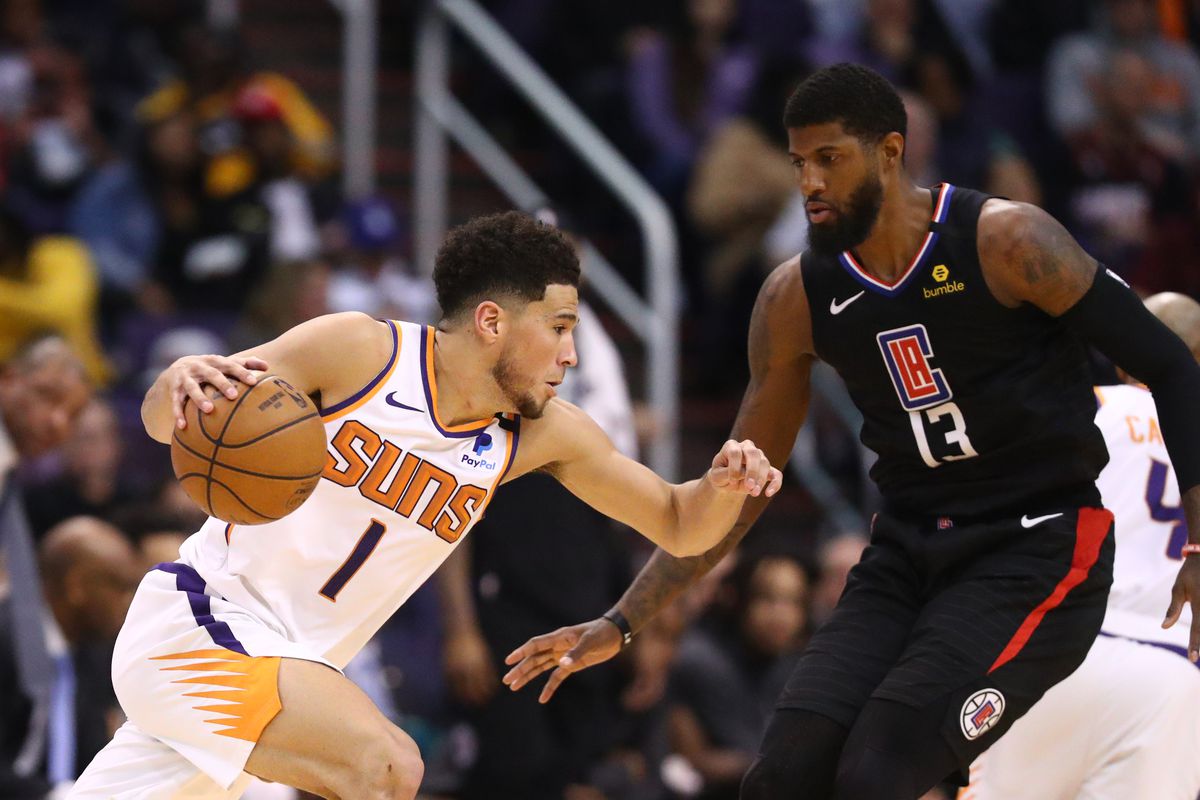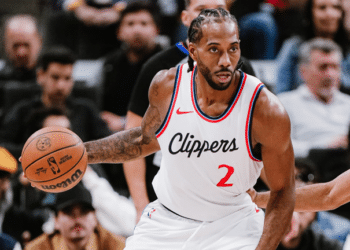By: Stephen Garner
Following a series sweep of the Nuggets, the Phoenix Suns had seven days off heading into game one of the Western Conference Finals.
They’ve been the best team in the NBA over the last three weeks, and have sustained a peak level of play at the aptest time of the season.
Spanning from the end of their series with the defending champions in the first round, they have compiled an eight-game win-streak and received consistent play from their ancillary players and that has snowballed into the most effective overall team play in the playoffs.
Ahead lies a unique challenge, however.
Suns vs Clippers
Speculation
Chris Paul
I expect CP3 to miss one of the first two games of this series. As I’m putting this post together, there’s a good chance some news regarding his availability could be released at any given moment. As it stands though, I believe he’ll miss one game.
Kawhi Leonard
I am under the assumption that Kawhi Leonard and his services will not be available at any point in this series, regardless of duration. I also reserve the thought that his season is done. Reported swelling and inflammation, in combination with the ACL talk that has surfaced, don’t bode well at all for his health. I think his health is completely compromised.
Clippers Outlook
Offensively
Sans Kawhi, they take on a more Paul George-center rendition.
He’s the driving force behind their offense, but their others (namely Marcus Morris and Reggie Jackson) consistently step up in a big way.
Six of the 9-10 players in their playoff rotation shoot north of 38% from 3. That’s everyone sans Zubac, Rondo, Beverly, and Cousins (though the latter three can certainly knock them down).
For anyone that’s watched the Clippers on a consistent level over the latter stretch of the season, you saw them deploy lineups where Marcus Morris was featured as their center.
In the regular season, typically with George or Leonard featured at the four, those lineups were ranked as the league best in scoring. At 133.5 PPG, those lineups compiled to rank in the 100th percentile on the near league best in eFG% at 61.7 and a +8 in the differential.
In the playoffs, said lineups are at 124.5 PPG on 58.8% in eFG, an overall +12.1.
Stylistically, these lineups are tailor-made to play the more traditional big men in the NBA off the floor. Regardless of who the opposition would relegate their big man to guarding, each of the players on the floor would be positioned on the perimeter (5-out offense).
If said big men cannot close out to the 3-point line, or defend in space without help, these lineups pose very cumbersome implications. See their neutralization of Rudy Gobert last series, and nearly playing Porzingis off the floor in the first round.
Defense
This is where the Clippers, regardless of Kawhi’s availability, can remain dominant.
They sport, defensively, the most versatile roster in the playoffs. This was the case in the first round when they were healthy and whole, and remain the same in the conference finals.
The luxury of their aforementioned small-ball lineup is that they have compiled a roster of two-way players that can function in a “positionless” defensive system.
In that, coach Tyronn Lue is presented with the opportunity to deploy many defensive schemes as well as adjust mid-game.
This is what they did in game 1. Sans Chris Paul, Devin Booker is easier to target in traps/zone schemes/switching schemes. They’re essentially defending Booker the same way that they defended Mitchell last series.
Lue has come out of timeouts in a zone defense to stifle ATO’s from opponents, switched to drop coverage in spurts, used their switch system, and deployed traps in pick and roll as well as “under 10” when the shot clock is down and offenses turn to isolation play.
Lue is a tactician from the sideline with his adjustments, and he is a big reason why they knocked the team with the best record in the NBA out last round.
Suns “Needs” to Advance to the Finals
Win the rebounds and turnovers battle, nightly
The Suns won the ball security battle each of their last series, but only won the rebounding battle versus Denver. They’ll need to win both entities, like the last series, for them to garner a result similar to that of their semi-finals showing.
Deandre Ayton (13.4 PPG, 9.8 RPG in eight-game win-streak) being the only traditional big man that will receive consistent minutes from game to game, his presence will be mandatory on the glass. Not only that, but it will be one of the biggest ways he can put his stamp on this series seeing that he won’t have a natural matchup.
He’s getting ancillary help from the lines of the Suns “gang rebounding” approach, but he has to be that force there.
Suns were a +4 on the glass in game one.
Ball Security
Phoenix had a historic series in ball security vs Denver. Over this win streak, they’re averaging 26.1 assists a game and just 9.5 turnovers. That elite ball security allows for them to keep control of games and maximize their possessions.
The keys for them here are in the hands of Chris Paul when he’s back, and Cam Payne who had 9 assists and just 1 turnover starting in place of CP3.
By Committee
In five of their last eight games, all five starters have scored in double figures. Even more, five of said eight games have also featured a bench player scoring in double figures, and one including two double-digit scorers off the bench.
The way the Suns have gotten the job done, amassing this eight-game playoff win-streak, has been their by-committee approach.
In said stretch:
Mikal Bridges – 14 PPG (48/33/85), 4 RPG
Jae Crowder – 13.1 PPG (51/49/86), 5.5 RPG
Cam Payne – 9.3 PPG, 3 APG
Cam Johnson – 7.1 PPG, 2.5 RPG
Torrey Craig – 5.6 PPG, 4.8 RPG
If the Suns continue to get this balanced attack of contributions, it will be hard-pressed to beat them on any given night but especially in 7 games.
Even more, these players all contribute viably on the defensive end, in tandem with their top three players (Booker, Paul, and Ayton).
Trust the System
Many of the sets the Suns run, using their pick and roll attack, is nearly tailor-made to combat defenses predicated in switching as they involve more than just the traditional big man screening for the ball-handler.
The use of double drag screens, as well as Spain pick-and-roll, put the opposition in scenarios where quick decision-making and communication are more exploitable.
These actions are essential because they keep Deandre Ayton involved. He’s developed such patience and feel in these particular scenarios that he should see success regardless of how the Clippers defend.
Attributed to reps & probably the aforementioned film he's watched of DeAndre Jordan, Aytons developed great feel on the floor with CP3. At 16.3 PPG & 10.5 RPG these playoffs, he's shown growth in screening & used early slips like here in a double drag pic.twitter.com/dB5UsjGYz6
— Stephen PridGeon
(@StayTrueSDot3) June 12, 2021
Notice the timing in which Ayton decided to roll here. This is a result of the reps he has with the Suns lead ball handlers but also just his growth as a roll man.
There were points yesterday, whether the Clippers were in a zone or switching, where Ayton delayed his roll, in an exaggerated fashion, to where he would be trailing whoever had the ball.
These subtle adjustments for him, as well as him being able to make quick passes on the roll, will lead to open looks time and time again.
Ball Movement
As mentioned earlier in regards to their ball security, the Suns are the best passing team in the NBA and are by far the best left in the playoffs.
Keeping a defense honest and having trust across the court that the ball will find the open man permeates throughout this roster.
This allows for them to beat double teams and late clock traps with great intention and attention to detail.
A perfect example of attention to detail from PHX. A few plays in a row, they moved the ball to the opposite corner for open 3's off of late clock double teams sent at Booker. LAC pre-rotated heavy, Bridges noticed & used the ball fake, then got an easy 2 pic.twitter.com/mI8dEuZqoV
— Stephen PridGeon
(@StayTrueSDot3) June 21, 2021
This play here was exactly the scenario that can win the Suns in this series. Decisive playmaking from Booker to Bridges, then timely action behind the double which led to an emphatic dunk at maybe the aptest juncture of the game as the Clippers were threatening.
The Suns moved the ball extremely well all game and kept the stifling Clippers defense on a string for most of the game. They punished them for doubling Booker time and time again, showing great poise.
Booker and Paul dominance
For all of the schemes Coach, Lue will deploy, if Booker and Paul continue to play to the standard they’ve set, this will be a quick series.
In tandem, they averaged 50.8 PPG against Denver in the second round.
They both did so in every way possible. At the rim, from deep, in pick and roll, in isolation, but especially from the mid-range.
A point I made soon as the Suns acquired CP3 was the tandem mid-range play that these two could use to beat any defensive coverage. This series will call for more of it from these two than either of the prior two.
In the one stretch where drop coverage was deployed, Booker aptly erupted for 16 straight points in the 3rd quarter, exclusively from the mid-range.
Reintegration of CP3 will only compound what Booker was able to do in game one. When he makes his return, I expect the Suns to resurface to their peak level of play, and do a better job in closing the Clippers out on a game-to-game basis.
Prediction

Given the state of each team, being down their most effective players and only one team expecting their guy to return soon, I just don’t think this series will run too long.
Suns in 5
*All stats come directly from basketball-reference.com unless stated otherwise and are accurate as of 6.20.21*


 NFL
NFL

 @StayTrueSdot3
@StayTrueSdot3 




